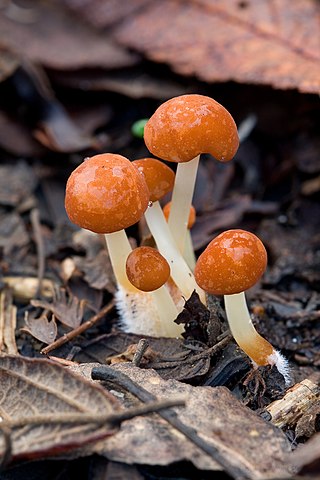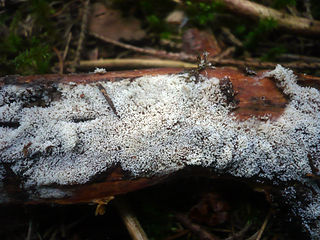| Cephaloscypha | |
|---|---|
| Scientific classification | |
| Kingdom: | |
| Division: | |
| Class: | |
| Order: | |
| Family: | |
| Genus: | Cephaloscypha Agerer (1975) |
| Type species | |
| Cephaloscypha morlichensis (W.B.Cooke) Agerer (1975) | |
Cephaloscypha is a fungal genus in the family Marasmiaceae. This is a monotypic genus, containing the single species Cephaloscypha morlichensis. The genus and species were described by mycologist Reinhard Agerer in 1975. [1]

Marasmius is a genus of mushroom-forming fungi in the family Marasmiaceae. It contains about 500 species of agarics, of which a few, such as Marasmius oreades, are edible. However, most members of this genus are small, unimpressive brown mushrooms. Their humble appearance contributes to their not being readily distinguishable to non-specialists, and they are therefore seldom collected by mushroom hunters. Several of the species are known to grow in the characteristic fairy ring pattern.

The Marasmiaceae are a family of fungi in the order Agaricales. Basidiocarps are most frequently agarics, but occasionally cyphelloid. According to a 2008 estimate, the family contained 54 genera and 1590 species, but molecular research, based on cladistic analysis of DNA sequences, has led to a more restricted family concept, so that the Marasmiaceae included just 13 genera, and some 1205 species. It was reduced further down in 2020, to 10 genera and about 700 species.
Pseudolasiobolus is a genus of fungus in the family Tricholomataceae. A monotypic genus, it contains the single species Pseudolasiobolus minutissimus, described by German mycologist Reinhard Agerer in 1983.

Collybia is a genus of mushrooms in the family Tricholomataceae. The genus has a widespread but rare distribution in northern temperate areas, and contains three species that grow on the decomposing remains of other mushrooms.
Palaeocephala is a genus of fungi. This is a monotypic genus, containing the single species Palaeocephala cymatelloides, described by Rolf Singer in 1962. According to the Dictionary of the Fungi, the genus is classified in either the Marasmiaceae or Physalacriaceae families; the taxonomical database MycoBank includes it in the Marasmiaceae.
Amyloflagellula is a genus of fungi in the family Marasmiaceae.
Aphyllotus is a fungal genus in the family Marasmiaceae. This is a monotypic genus, containing the single species Aphyllotus campanelliformis, found in Colombia. Both the species and the genus were described by mycologist Rolf Singer in 1973.
Cymatellopsis is a genus of fungus in the mushroom family Marasmiaceae. This is a monotypic genus, containing the single species Cymatellopsis ilmiana, found in east Africa.
Deigloria is a genus of agaric fungus in the family Marasmiaceae. Described by mycologist Reinhard Agerer in 1980, the genus contains 10 species that are widespread in neotropical areas. The generic name derives from the Latin words Deus (God) and gloria (glory).
Epicnaphus is a genus of mushroom-forming fungi in the family Marasmiaceae. The genus, circumscribed by mycologist Rolf Singer in 1960, contains two species found in South America. Fruitbodies of Epicnaphus species are similar in appearance to those in Marasmius section Sicci, but have a smooth hymenium and broom cells of the Rotalis-type. Singer initially included only the type species, E. phalaropus, which was originally collected from fallen branches in a Bolivian rainforest. The Argentinian species E. longispora was added to the genus by Jörg Raithelhuber in 1973.
Fissolimbus is a fungal genus in the family Marasmiaceae. This is a monotypic genus, containing the single species Fissolimbus fallaciosus, found in Papua New Guinea. The genus and species were described as new to science in 1979.

Henningsomyces is a genus of fungi in the family Marasmiaceae.
Manuripia is a fungal genus in the family Marasmiaceae. It is a monotypic genus, containing the single species Manuripia bifida, found in South America.
Lecanocybe is a genus of fungus in the mushroom family Marasmiaceae. This is a monotypic genus, containing the single species Lecanocybe lateralis, found in Java and Hawaii.

Moniliophthora is a genus of fungi in the family Marasmiaceae. The genus was described in 1978 with M. roreri as the type species. This fungus, formerly known as Monilia roreri, causes frosty pod rot, a serious disease of Theobroma cacao.
Phaeodepas is a genus of fungus in the family Marasmiaceae. The genus contains two species found in Venezuela.

Rectipilus is a genus of cyphelloid fungi in the family Marasmiaceae. The widespread genus contains nine species. It was circumscribed by Reinhard Agerer in 1973.

The cyphelloid fungi are a group of fungi in the Basidiomycota that have disc-, tube-, or cup-shaped basidiocarps, resembling species of discomycetes in the Ascomycota. They were originally referred to the genus Cyphella and subsequently to the family Cyphellaceae, but are now known to be much more diverse and are spread through several different genera and families. Since they are often studied as a group, it is convenient to call them by the informal (non-taxonomic) name of "cyphelloid fungi". Better known cyphelloid genera include Calyptella, with stalked, cup- or bell-like fruit bodies; Lachnella, with conspicuous, hairy-margined, disc-like fruit bodies; Flagelloscypha with smaller, but equally hairy, cup-like fruit bodies; Henningsomyces with tube-like fruit bodies; and Merismodes with clustered, hairy, cup-like fruit bodies.
Neocampanella is a genus of fungus in the family Marasmiaceae. The genus is monotypic, containing the single species Neocampanella blastanos.